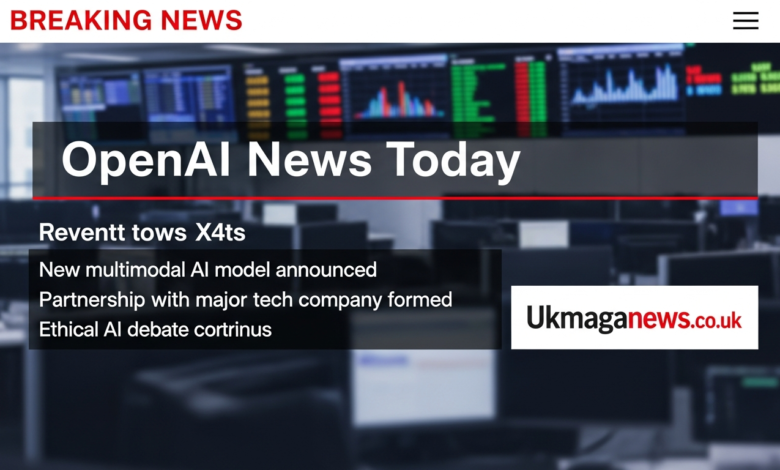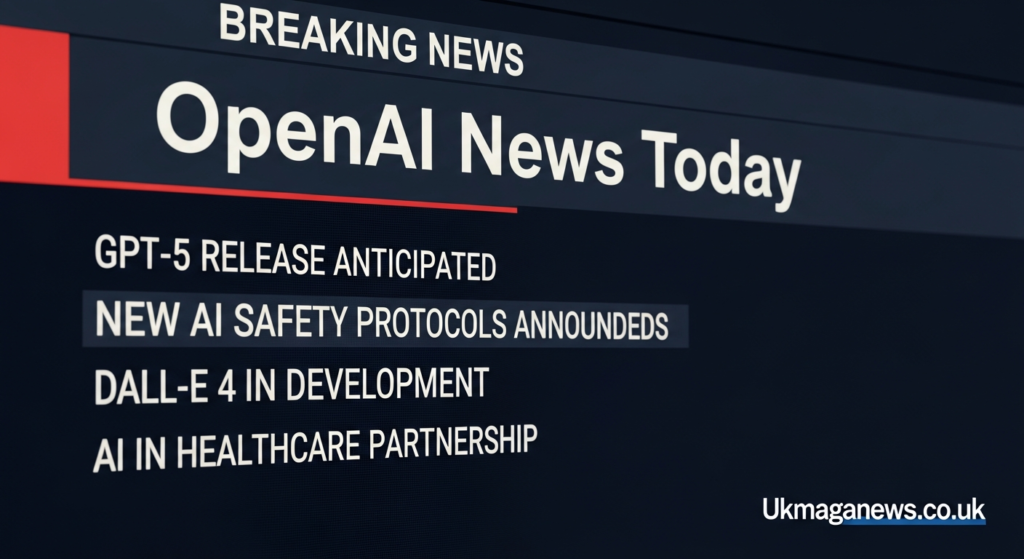OpenAI News Today: Latest Updates and Breakthrough Reveals

Introduction
Artificial intelligence is moving faster than ever, and OpenAI sits at the center of this revolution. Every week brings new announcements, model updates, and developments that reshape how we interact with technology. If you’re trying to keep up with OpenAI news today, you know how quickly things change in the AI landscape.
I’ve been following OpenAI’s journey since the early days of GPT-3, and the pace of innovation continues to accelerate. Whether you’re a developer building AI applications, a business leader exploring AI integration, or simply curious about where technology is headed, staying current with OpenAI developments matters more than ever.
This article brings you the latest OpenAI news today, covering recent announcements, product updates, research breakthroughs, and what these developments mean for you. We’ll explore new features rolling out across ChatGPT and the API, discuss competitive dynamics in the AI industry, and examine how OpenAI’s work influences the broader technology landscape.
You’ll walk away understanding not just what’s happening with OpenAI, but why it matters and how these changes might affect your work, creativity, or daily life.
Recent OpenAI Announcements and Product Updates
ChatGPT Feature Releases
OpenAI continuously enhances ChatGPT with new capabilities that expand what the platform can do. Recent updates have focused on making the tool more powerful, accurate, and accessible to broader audiences.
The latest ChatGPT iterations include improved reasoning capabilities. The models now handle complex multi-step problems more effectively. You’ll notice better performance on mathematical calculations, coding tasks, and logical reasoning challenges.
Voice mode improvements have made conversations more natural. The technology now understands context better and responds with appropriate tone and pacing. Many users report that interactions feel increasingly human-like.
Image generation and analysis features continue evolving. You can now have more detailed conversations about images, and the system understands visual context with greater accuracy. These improvements benefit creative professionals, educators, and anyone working with visual content.
Search integration represents a significant advancement. ChatGPT can now browse the web for current information in real time. This addresses one of the system’s biggest historical limitations: knowledge cutoff dates.
API and Developer Tool Updates
OpenAI regularly updates its API offerings, giving developers new tools for building AI-powered applications. These updates often fly under the radar but significantly impact how businesses use AI.
Rate limit increases have made the API more accessible for high-volume applications. Developers building enterprise solutions now have more flexibility. This change supports the growing ecosystem of applications powered by OpenAI technology.
New model variants offer different trade-offs between speed, cost, and capability. You can now choose models optimized for specific use cases. Need fast responses for a chatbot? There’s a model for that. Require deep reasoning for complex analysis? Another model handles that better.
Function calling improvements let AI systems interact with external tools more reliably. This enables sophisticated workflows where AI coordinates multiple systems. The practical applications range from customer service automation to complex data analysis pipelines.
Pricing adjustments reflect OpenAI’s ongoing efforts to make AI more affordable. As efficiency improves, costs decrease. This democratization makes advanced AI accessible to smaller organizations and independent developers.
New Model Releases
OpenAI’s model releases generate significant attention across the technology industry. Each new generation brings measurable improvements in capability, efficiency, and reliability.
The latest models demonstrate enhanced reasoning abilities. Benchmarks show improvements across mathematical problem solving, coding, and logical analysis. These aren’t marginal gains but substantial leaps forward.
Context window expansions let models process more information simultaneously. Longer context windows enable applications like analyzing entire books, processing large codebases, or maintaining coherent long-form conversations.
Reduced hallucination rates address a critical concern. Earlier models sometimes confidently stated incorrect information. Newer versions are more likely to acknowledge uncertainty and provide accurate responses.
Multimodal capabilities continue improving. Models that understand text, images, and audio together create richer interaction possibilities. You can discuss documents that combine text and charts or analyze videos with spoken content.
OpenAI’s Competitive Landscape
Competition from Google and Anthropic
The AI industry has become intensely competitive, with major players racing to develop the most capable systems. OpenAI faces serious competition from well-funded rivals.
Google’s Gemini models represent a formidable challenge. Google’s vast resources, data access, and integration with existing products create advantages. Gemini’s multimodal capabilities from the ground up provide unique strengths.
Anthropic, founded by former OpenAI researchers, offers Claude as a direct competitor. Many users praise Claude’s helpfulness and reduced likelihood of producing problematic content. The competition pushes all players to improve.
Meta’s Llama models take a different approach through open sourcing. Making powerful models freely available creates an ecosystem that doesn’t depend on OpenAI’s API. This openness appeals to organizations wanting control over their AI infrastructure.
Smaller companies and research labs contribute innovation too. The AI landscape includes dozens of organizations developing specialized models. This diversity drives rapid advancement across the entire field.
OpenAI’s Strategic Positioning
OpenAI maintains competitive advantages despite increasing rivalry. Understanding these strengths helps explain the company’s continued prominence.
First-mover advantage in consumer AI applications matters enormously. ChatGPT became synonymous with conversational AI for millions of users. This brand recognition provides staying power even as alternatives emerge.
The Microsoft partnership brings crucial resources and distribution. Azure integration makes OpenAI technology available to enterprise customers globally. This relationship accelerates adoption in business contexts.
Continuous improvement cycles keep OpenAI’s models competitive. The company releases updates frequently, ensuring they don’t fall behind rivals. This commitment to iteration maintains technical leadership.
The developer ecosystem built around OpenAI’s API creates switching costs. Applications built on OpenAI technology require effort to migrate to alternatives. This installed base provides business stability.
Market Impact and Industry Influence
OpenAI’s actions ripple across the entire technology industry. Understanding this influence provides context for why OpenAI news today matters beyond just one company.
Product announcements from OpenAI often trigger responses from competitors. When OpenAI releases new capabilities, rivals rush to match or exceed them. This competitive dynamic accelerates AI advancement industry-wide.
Pricing decisions at OpenAI influence market rates. When OpenAI reduces API costs, competitors face pressure to follow. This benefits customers but intensifies competition among providers.
Research published by OpenAI shapes academic and industry priorities. Papers from OpenAI researchers generate thousands of citations. The company’s research directions influence what others investigate.
Ethical stances taken by OpenAI contribute to broader policy discussions. Decisions about safety, transparency, and access inform regulatory conversations globally. OpenAI’s positions influence how society approaches AI governance.

AI Safety and Alignment Research
Recent Safety Developments
OpenAI dedicates significant resources to making AI systems safer and more aligned with human values. Recent safety work addresses some of AI’s most challenging problems.
Reinforcement learning from human feedback continues evolving. This technique trains AI systems to produce outputs humans prefer. Improvements in RLHF methodology make systems more helpful and less likely to produce harmful content.
Red teaming efforts identify potential misuses before public release. Dedicated teams try to make models behave badly, revealing vulnerabilities. Findings inform safety improvements before millions of users encounter issues.
Constitutional AI research explores scalable oversight methods. As AI systems become more capable, human supervision becomes more difficult. New approaches enable AI systems to help supervise other AI systems safely.
Interpretability research aims to understand what happens inside AI systems. Neural networks operate as black boxes, making it hard to predict behavior. Improved interpretability helps identify and fix problems before they cause harm.
Addressing AI Risks
OpenAI publicly acknowledges risks posed by advanced AI systems. The company’s approach to risk management influences industry standards.
Misuse prevention measures limit harmful applications. API policies prohibit using OpenAI technology for weapons, surveillance, or misinformation campaigns. Enforcement mechanisms detect and block violations.
Bias mitigation efforts address fairness concerns. AI systems can perpetuate or amplify societal biases present in training data. Ongoing work reduces these biases, though complete elimination remains challenging.
Economic disruption from AI automation receives serious attention. OpenAI leadership discusses potential job displacement and advocates for policies supporting affected workers. This broader perspective acknowledges responsibilities beyond just technology development.
Existential risk from superintelligent AI motivates long-term safety research. While controversial, OpenAI takes seriously the possibility that future AI systems could pose fundamental risks. Alignment research aims to ensure advanced systems remain beneficial.
Collaboration and Transparency
OpenAI’s approach to safety involves collaboration with external researchers and some level of transparency about risks and mitigations.
Academic partnerships bring diverse perspectives to safety challenges. University researchers work with OpenAI on alignment problems. These collaborations generate publications advancing the entire field’s understanding.
Bug bounty programs invite security researchers to find vulnerabilities. Paying researchers who discover problems incentivizes thorough testing. This crowdsourced security improves system robustness.
Red team results are sometimes published, providing transparency about potential issues. Sharing findings helps other organizations avoid similar problems. This openness contributes to industry-wide safety improvements.
Safety research papers make techniques available to other organizations. While OpenAI keeps some capabilities proprietary, safety methods are often shared. This approach recognizes that AI safety benefits everyone.
Business and Enterprise Applications
ChatGPT Enterprise Features
OpenAI offers specialized versions of ChatGPT designed for business use. These enterprise features address concerns that prevent some organizations from adopting consumer AI tools.
Data privacy guarantees ensure conversations aren’t used for model training. Businesses handling sensitive information need assurance their data remains confidential. Enterprise agreements provide legal protections and technical safeguards.
Administrative controls let organizations manage employee access. IT departments can provision accounts, set usage policies, and monitor adoption. These management capabilities matter for large-scale deployment.
Higher usage limits accommodate intensive professional use. Enterprise users aren’t constrained by the rate limits affecting free or individual subscriptions. This enables AI to become a core productivity tool.
Advanced analysis features provide deeper insights. Enterprise versions include capabilities for processing larger datasets and performing more complex analyses. These tools support decision-making in business contexts.
Industry-Specific Applications
Different industries apply OpenAI technology in specialized ways. Recent developments show increasing sophistication in sector-specific applications.
Healthcare organizations use AI for medical documentation and research analysis. Physicians employ AI to summarize patient histories and suggest differential diagnoses. Researchers analyze medical literature at unprecedented scale.
Legal professionals leverage AI for document review and legal research. Contracts can be analyzed for specific clauses. Case law research that once took hours now takes minutes. These efficiency gains reshape legal practice.
Financial services apply AI to analysis and customer service. Investment research, risk assessment, and fraud detection all benefit from AI capabilities. Chatbots handle routine customer inquiries, freeing humans for complex issues.
Education technology incorporates AI for personalized learning. Students receive customized explanations tailored to their understanding. Teachers use AI to generate lesson materials and assessments. Educational applications balance AI assistance with maintaining academic integrity.
Developer Ecosystem Growth
The community of developers building on OpenAI technology continues expanding. This ecosystem creates value far beyond what OpenAI produces directly.
Third-party applications number in the thousands. Developers have built tools for content creation, coding assistance, data analysis, and countless other purposes. This explosion of applications demonstrates the platform’s versatility.
Integration platforms simplify connecting OpenAI to other services. Tools like Zapier and Make.com let non-technical users incorporate AI into workflows. These integrations accelerate AI adoption across organizations.
Open-source projects build on OpenAI’s API. Developers create frameworks, utilities, and applications they share freely. This collaborative development accelerates innovation and makes AI more accessible.
Consulting and services businesses have emerged around OpenAI implementation. Organizations need help designing AI strategies, building custom applications, and training employees. This professional services ecosystem supports enterprise adoption.
Research Breakthroughs and Technical Advances
Improvements in Model Capabilities
OpenAI’s research team continuously pushes the boundaries of what AI systems can accomplish. Recent technical advances demonstrate progress on fundamental challenges.
Reasoning capabilities have improved dramatically. Models now solve multi-step problems more reliably. Mathematical word problems, logical puzzles, and strategic planning all show measurable improvement.
Code generation quality has reached impressive levels. AI can now write functional code for complex tasks. While not replacing human developers, these tools dramatically accelerate software development.
Language understanding subtleties continue improving. Models better grasp context, tone, and implied meaning. Conversations feel more natural as the AI picks up on nuances human communication relies on.
Factual accuracy has increased through better training and evaluation methods. Models are more likely to provide correct information and less likely to confidently state falsehoods. This reliability improvement is crucial for practical applications.
Novel Training Techniques
Research into how AI systems learn yields techniques that make models more capable and efficient. These methodological advances often matter more than raw compute power.
Efficient fine-tuning methods let smaller organizations customize models. Techniques like LoRA and parameter-efficient fine-tuning require less data and computation. This democratizes access to custom AI systems.
Mixture of experts architectures improve efficiency. Instead of activating entire neural networks for every task, only relevant parts engage. This approach provides capability without proportional compute increases.
Reinforcement learning innovations improve how models learn from feedback. New algorithms make learning more sample-efficient. Models achieve better performance with less training data.
Continual learning research addresses how to update models without forgetting previous knowledge. This enables models to stay current as information changes. Solving continual learning would reduce the need for complete retraining.
Multimodal AI Progress
Systems that understand multiple types of input simultaneously represent a frontier in AI research. OpenAI’s multimodal work enables richer applications.
Vision and language integration continues improving. Models can discuss images with increasing sophistication. They understand spatial relationships, identify objects, and analyze artistic elements.
Audio processing capabilities enable natural voice interactions. Speech recognition, generation, and understanding work together seamlessly. This creates more accessible and convenient interfaces.
Video understanding remains challenging but shows progress. Analyzing moving images requires understanding temporal relationships. Early capabilities demonstrate potential for applications in content analysis and creation.
Cross-modal reasoning allows novel applications. A model might analyze a chart, read accompanying text, and synthesize insights drawing on both. These integrative capabilities mirror human multimodal understanding.
Impact on Content Creation and Creative Industries
Writing and Content Generation
AI tools have transformed content creation workflows. Writers across industries now incorporate AI assistance in various ways.
Draft generation provides starting points for refinement. Instead of facing blank pages, writers begin with AI-generated outlines or rough drafts. Human creativity focuses on editing, structuring, and adding unique perspectives.
Research assistance accelerates information gathering. AI can quickly summarize sources, identify relevant information, and suggest connections between ideas. This speeds the research phase of content creation.
Style adaptation helps writers adjust tone for different audiences. AI can rewrite content at different reading levels or for different platforms. A single piece might be adapted for academic, business, and general audiences.
Translation and localization extend content reach. AI translation quality now enables reasonable communication across language barriers. Content creators can address global audiences more easily.
Visual Arts and Design
AI image generation has exploded in capability and adoption. These tools change how visual content gets created.
Concept visualization helps designers explore ideas quickly. Instead of sketching dozens of variations, designers generate options with AI. This speeds the creative exploration phase.
Asset creation for games and media benefits from AI efficiency. Background elements, textures, and variations can be generated automatically. Human artists focus on hero assets and creative direction.
Personalization at scale becomes feasible. Marketing materials can feature variations tailored to different audiences. This level of customization was previously too expensive for most applications.
Accessibility improvements help non-artists create visual content. Small businesses and individuals can generate professional-looking graphics without design expertise. This democratization has both opportunities and concerns.
Music and Audio Production
AI applications in audio and music production continue developing, though they lag behind text and image capabilities.
Music generation tools create background tracks and loops. Content creators need audio for videos, podcasts, and presentations. AI-generated music provides royalty-free options.
Audio editing assistance speeds production workflows. Tasks like noise reduction, audio enhancement, and basic mixing can be automated. This lets producers focus on creative decisions.
Voice synthesis creates realistic artificial voices. Narration, character voices, and multilingual content become easier to produce. Ethical questions around voice cloning require careful consideration.
Sound design for media benefits from AI-generated effects. Creating unique sounds for games, films, or podcasts traditionally requires expertise and time. AI tools make sound design more accessible.
Educational Implications and Learning Applications
AI as a Learning Tool
Educational institutions and individual learners increasingly incorporate AI into learning processes. These applications show promise but also raise important questions.
Personalized tutoring provides explanations tailored to individual understanding. Students can ask questions and receive patient, customized responses. This one-on-one attention was previously available only to privileged students.
Practice problem generation creates unlimited exercises. Students can practice skills until mastery without exhausting available problems. AI generates variations maintaining appropriate difficulty levels.
Feedback on work helps students improve without waiting for instructor availability. Essays, code, and problem solutions can receive immediate preliminary feedback. This accelerates the learning cycle.
Language learning applications leverage conversational AI. Students practice speaking and writing with patient AI partners. The systems adapt to proficiency levels and provide corrections.
Challenges for Academic Integrity
AI capabilities create significant challenges for educational assessment. Schools and universities grapple with ensuring work represents student learning.
Essay detection tools try to identify AI-generated content. However, sophisticated AI writing becomes increasingly difficult to distinguish from human work. This arms race continues without clear resolution.
Assignment redesign shifts toward AI-resistant formats. More emphasis on oral presentations, in-class work, and projects requiring personal reflection makes AI assistance less directly applicable.
Policy development around appropriate AI use varies across institutions. Some ban AI entirely, others embrace it with attribution requirements. Educational philosophy about AI’s role influences these policies.
Student literacy about AI capabilities and limitations becomes important. Understanding what AI can and cannot do helps students use it appropriately. Critical thinking about AI-generated content is an increasingly important skill.
Future of Education with AI
Looking forward, AI will likely fundamentally reshape educational experiences and institutions.
Adaptive learning systems could revolutionize instruction. Content, pacing, and assessment might adapt continuously to individual student needs. This personalization could dramatically improve learning outcomes.
Teacher roles may evolve from information delivery to facilitation and mentorship. If AI handles content explanation, human educators focus on motivation, social-emotional support, and higher-order thinking.
Access to quality education could expand dramatically. AI tutors available to anyone with internet access reduce educational inequality. Geographic and economic barriers to learning diminish.
Assessment methods will need fundamental reconceptualization. If AI can complete traditional assignments, education must measure different competencies. Critical thinking, creativity, and collaboration may become more central to evaluation.
Regulatory and Policy Developments
Government Approaches to AI Regulation
Governments worldwide are developing approaches to AI regulation. These policies will shape how OpenAI and others can develop and deploy AI systems.
The European Union’s AI Act represents comprehensive regulatory framework. Risk-based categorization determines requirements for different AI applications. High-risk systems face strict requirements, while minimal-risk systems have fewer constraints.
United States approaches emphasize sector-specific regulation. Rather than comprehensive AI legislation, existing regulatory bodies address AI in their domains. The FDA considers medical AI, the FTC examines consumer protection, and other agencies address their areas.
China’s approach combines promoting AI development with strict content controls. The government encourages AI innovation while maintaining censorship capabilities. This creates a distinct AI ecosystem with different characteristics than Western systems.
International coordination efforts aim to create compatible standards. Organizations like the OECD work on AI principles that multiple countries endorse. However, significant differences in regulatory philosophy remain.
OpenAI’s Policy Engagement
OpenAI actively participates in policy discussions about AI governance. The company’s positions influence regulatory conversations.
Testimony before legislative bodies provides policymaker education. OpenAI leaders explain AI capabilities and risks to government officials. This input shapes regulatory approaches.
Published policy proposals suggest frameworks for AI governance. OpenAI has advocated for certain regulatory approaches, including licensing requirements for very powerful systems.
Industry coalitions bring AI companies together on policy issues. Collaborative efforts create unified positions on questions affecting multiple organizations. These coalitions have more influence than individual companies.
Transparency reports provide information about AI use and misuse. Publishing data about API usage patterns, content policy violations, and safety incidents contributes to public understanding.
Ethical Considerations and Public Debate
Broader societal questions about AI extend beyond specific regulations. These ethical debates influence public opinion and policy.
Job displacement concerns drive significant public anxiety. Automation of cognitive work affects professional workers previously insulated from technological disruption. Society must address potential unemployment and inequality.
Misinformation and manipulation risks worry many observers. AI-generated content could undermine truth and democratic deliberation. Detecting and countering AI-generated misinformation presents technical and policy challenges.
Privacy implications arise from AI systems that analyze personal data. Training models on internet data raises consent questions. Applying AI to surveillance threatens privacy rights.
Concentration of AI power in few organizations concerns advocates for competitive markets and democratic control. If only large companies can develop advanced AI, this creates power imbalances with broad implications.
Looking Ahead: Future Developments
Anticipated Near-Term Advances
Based on current trajectories, certain capabilities will likely emerge in the near future. These developments will shape the next phase of AI applications.
Longer context windows will enable new applications. Imagine AI that can process entire codebases, books, or conversation histories simultaneously. This expanded memory unlocks qualitatively different capabilities.
Improved multimodal integration will create richer interactions. Systems that seamlessly combine text, images, audio, and video understanding will enable more natural and powerful applications.
Better reasoning capabilities will make AI more reliable for complex tasks. As logical reasoning improves, AI can handle more sophisticated analysis and planning. This expands applicable domains significantly.
Reduced costs through efficiency improvements will democratize access. As models become more efficient, prices drop. This makes advanced AI available to more individuals and organizations.
Potential Long-Term Trajectories
Looking further ahead, AI development could take various paths. These scenarios remain uncertain but help frame thinking about the future.
Artificial General Intelligence represents the goal of human-level AI across domains. When or whether this will be achieved remains hotly debated. AGI would represent a fundamental transition in human history.
Specialized AI systems might proliferate instead of general intelligence. Different domains could have expert systems without human-level general capability. This future looks more like today’s trajectory extending forward.
Integration with other technologies could create hybrid capabilities. Combining AI with robotics, biotechnology, or quantum computing might enable applications we cannot currently imagine.
Societal adaptation will shape AI’s ultimate impact as much as technical capabilities. How humanity chooses to use AI, what regulations are implemented, and how economic systems adapt all matter enormously.
OpenAI’s Strategic Direction
OpenAI’s own plans and priorities will significantly influence the AI landscape. Understanding the company’s direction provides insight into future developments.
Safety and alignment remain stated priorities. OpenAI emphasizes that advancing capabilities safely matters more than being first. Whether actions match rhetoric remains subject to debate.
Democratization through API access and consumer products continues as a strategy. Making AI widely available furthers OpenAI’s mission while building a sustainable business.
Research into next-generation architectures seeks fundamental breakthroughs. Beyond incrementally improving existing approaches, OpenAI explores novel AI paradigms. These research bets could yield dramatic advances.
Partnership and ecosystem development expand OpenAI’s reach. Working with Microsoft, supporting developers, and collaborating with researchers multiply the company’s impact beyond direct products.

Conclusion
OpenAI news today reflects an industry and technology evolving at remarkable speed. From new model releases to API updates, safety research to competitive dynamics, developments come rapidly. Staying informed about these changes helps you understand how AI will affect your work, creativity, and daily life.
The company continues pushing boundaries in AI capability while grappling with safety, ethics, and societal impact. Competition from Google, Anthropic, and others drives rapid advancement across the industry. This competitive dynamic benefits users through better products and lower costs.
As AI becomes more capable and widespread, its implications grow more profound. Educational applications transform learning. Creative tools reshape content production. Business automation changes workflows across industries. These shifts have just begun.
Following OpenAI news today keeps you aware of what’s possible with current technology. Understanding the trajectory helps you anticipate changes and opportunities. Whether you’re building AI applications, using AI tools professionally, or simply curious about the future, staying informed matters.
What OpenAI development interests or concerns you most? How are you incorporating AI into your work or life? The conversation about AI’s role in society needs diverse voices and perspectives. Your engagement with these questions helps shape how AI develops and gets used.
FAQs
What is the latest OpenAI model release? OpenAI regularly releases updated models with improved capabilities. The latest versions feature enhanced reasoning, longer context windows, and better multimodal understanding. Check OpenAI’s official website or blog for the most current model information and release announcements.
How much does OpenAI’s API cost? Pricing varies by model and usage volume. OpenAI charges based on tokens processed, with different rates for input and output. Newer, more capable models typically cost more per token. Visit OpenAI’s pricing page for current rates across different models.
Is ChatGPT free to use? ChatGPT offers both free and paid tiers. The free version provides access to capable models with usage limitations. ChatGPT Plus, a subscription service, offers faster responses, priority access, and the most advanced models. Enterprise versions with additional features are also available.
How does OpenAI compare to Google’s Gemini? Both offer powerful AI capabilities with different strengths. OpenAI has first-mover advantage and wide adoption. Google brings vast resources and data access. Specific performance varies by task, with each excelling in different areas. Many users find both valuable for different purposes.
What safety measures does OpenAI implement? OpenAI employs multiple safety approaches including reinforcement learning from human feedback, content filtering, usage policies, and ongoing research into alignment. The company conducts red teaming exercises and collaborates with external researchers. Safety remains an active research area with continuous improvements.
Can businesses use OpenAI technology? Yes, OpenAI offers enterprise products and API access specifically for business use. ChatGPT Enterprise provides enhanced privacy, security, and administrative controls. The API enables building custom applications. Many businesses across industries have integrated OpenAI technology into their operations.
How accurate is information from ChatGPT? Accuracy has improved significantly but isn’t perfect. ChatGPT can make mistakes, especially on obscure topics or very recent information. The system sometimes presents incorrect information confidently. Always verify important information from authoritative sources. Web browsing features help with current information.
What industries use OpenAI technology most? Healthcare, legal services, financial services, education, content creation, customer service, and software development are major users. Essentially every industry explores AI applications. Use cases range from document analysis to customer interaction, research assistance to creative production.
How can developers access OpenAI’s API? Developers create accounts at platform.openai.com, provide payment information, and receive API keys. Documentation explains implementation details for different programming languages. The playground environment allows testing without coding. Rate limits and pricing vary by account type and usage volume.
What’s next for OpenAI? OpenAI continues advancing model capabilities, expanding multimodal features, and improving safety. The company focuses on making AI more useful, accessible, and aligned with human values. Specific future announcements remain confidential, but expect continued rapid development across multiple dimensions of AI capability.
Also read Ukmaganews.co.uk




